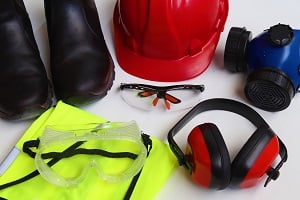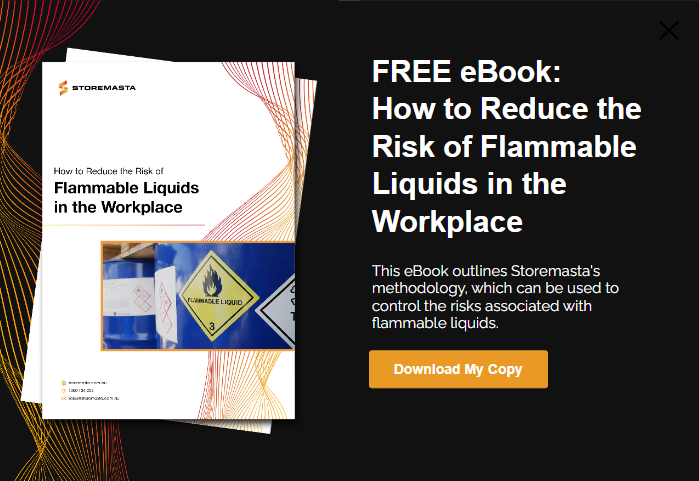Whenever flammable or combustible liquids are used and stored at a worksite, everyone onsite must be provided with personal protective equipment (PPE). This PPE must be appropriate for the job that they do; providing sufficient protection against the amount of chemical exposure that they face. To help you navigate the PPE requirements of the Australian Standard AS 1940:2017, we’ve put together a step-by-step guide on how to select PPE for your workplace. We’ll detail the types of PPE for flammable liquids, as well as the storage, care and maintenance, and staff training requirements that are detailed in the Standard.
IMPORTANT: Personal protective equipment on its own is not a sufficient risk control measure as it only places a temporary barrier between the worker and the hazard. Ideally, organisations should aim to eliminate a hazard completely or use a chemical that is less hazardous.
What Are The Different Types Of PPE?
The Australian Standard AS 1940:2017 - The storage and handling of flammable and combustible liquids, details 3 key general requirements for the provision of PPE.
The Standard states that:
9.12 PERSONAL PROTECTIVE EQUIPMENT (PPE)
9.12.1 General
Where flammable or combustible liquids are kept or handled—
(a) all persons on the premises shall be provided with appropriate personal protective equipment;
(b) personal protective equipment shall be kept in designated, well-identified locations and ready for use; and
(c) all personal protective equipment shall be maintained in good condition
The first requirement explains that every person should be equipped with ‘appropriate’ PPE in any area where Class 3 Dangerous Goods are stored or handled by staff.
To determine the exact PPE requirements for your workplace, you must refer to the Safety Data Sheets (SDSs) for each of the flammable liquids that your business is carrying.
Each SDS will contain details about the type of PPE required when staff are handling that flammable chemical.
The detailed information from the SDS will then form the basis of your workplace risk assessment. Your assessment should consider the ways in which the flammable liquids are being used and stored at your workplace.
To give an example of the PPE requirements from an SDS, we’ve included the information from an SDS for Automotive Diesel Fuel:
Wear safety shoes, overalls, gloves, safety glasses. Available information suggests that gloves made from nitrile rubber should be suitable for intermittent contact. However, due to variations in glove construction and local conditions, the user should make a final assessment.
As you can see from the above information, the recommendation in the SDS is for nitrile gloves. However, the SDS then prompts the WHS Manager to conduct their own independent risk assessment.
Need an end-to-end risk assessment?
PPE For Handling and Storing Flammable Liquids
AS 1940:2017 outlines the following PPE to be used when staff are handling and storing Class 3 Flammable Liquids:
1. Eye Protection
Workers should wear eye protection (complying with AS/NZS 1337) when handling flammable liquids.
Of course, the type of eye protection worn will depend on the toxicity of the chemical (is it corrosive or carcinogenic?) as well as the way it is being handled (is the dispensing or refueling station fully contained or is there a risk of the fuel splashing onto the face or eyes?).
 It’s a requirement of AS 1940:2017 that eye protection is worn when staff are handling class 3 Flammable Liquids.
It’s a requirement of AS 1940:2017 that eye protection is worn when staff are handling class 3 Flammable Liquids.
Eye protection can include safety glasses, goggles, and face shields and you should make sure the units are chemical resistant and fitted to each worker individually. When googles or eye guards don’t fit staff correctly, they could distract a worker filling a container with petrol. This could result in them losing focus and making a dangerous error such as spilling flammable liquids.
REMEMBER: Eyewear must do more than just protect the eyes from splashes, vapours from flammable fuels and solvents can irritate the eyes and cause permanent injuries.
Protective Gloves
Protective gloves should be worn by workers handling flammable liquids. Consulting the SDS is the best place to begin when deciding on what type of protective gloves to use. Hands need protecting from the liquids, but the gloves must also be impervious to chemical vapours.
You should always check the manufacturer’s guidelines carefully to determine just how chemical resistant the gloves are.
Gloves also need to be fitted correctly, as loose-fitting gloves can be penetrated by hazardous liquids and vapours. Protective gloves that don’t fit staff properly could cause an operator to make an error, such as losing grip while driving a forklift.
It’s also important that you ensure that there are enough gloves in stock. Each worker must have access to their own pair of gloves, plus a backup supply. When selecting protective gloves make sure that they comply with AS/NZS 2161.
Safety Footwear
Safety footwear is essential under the Standard and must meet the requirements of AS/NZS 2210. Again, make sure the boots fit properly and fully protect the feet from flammable liquids, vapours or flames.

To protect staff from the risks associated with flammable liquids, you should ensure that compliant safety footwear is worn by personnel.
Headwear
Some workplaces require workers, contractors and site personnel to wear hard hats or helmets.
If your business requires headwear, it should meet the requirements of AS/NZS180. The helmets should be compatible with the chemical properties of the fuels or solvents being used by the worker. The headwear should also fit the worker properly and be kept maintained in accordance with the Standard.
Breathing Apparatus
When breathing apparatus is required at a worksite, make sure that respirators having appropriate filters, and any self-contained breathing apparatus complies with AS/NZS 1716. They must also be selected, used and maintained in accordance with AS/NZS 1715.
In determining your breathing apparatus requirements, make sure that you always check the SDS and consult your chemical supplier.
Protective Clothing
Wearing protective clothing, such as overalls, is often specified on the Safety Data Sheets (SDSs) for various fuels, solvents and flammable liquids. When selecting the right protective clothing, you should invest in thorough research about the clothing to ensure it’s compatible with the flammable chemicals that are being used in your organisation.
Hearing Protection
While hearing protection is not specifically listed in the requirements for staff handling flammable liquids, there may be a requirement for this type of PPE in your workplace. If your risk assessment does determine that hearing protection is required, the ear guards must comply with AS/NZS 1270.
How Do You Store PPE?
Job sites and work areas should be designed so that staff can easily access their PPE before starting their duties. They should also know exactly where and how to put the PPE away when it’s not in use.
A secure safety cabinet that protects PPE from the weather, dust, heat, and vermin is the ideal choice for PPE storage.
 Staff must know how to access their PPE as well as the procedures for putting it away.
Staff must know how to access their PPE as well as the procedures for putting it away.
PPE storage cabinets are available to suit both indoor and outdoor work areas. There are also various types of cabinets to store the various types of PPE.
If PPE is not properly returned to its designated location at the end of a shift or if incoming workers can’t access a locked PPE cabinet, serious accidents can occur. PPE should be stored in a clearly marked cabinet that’s located close to the flammable liquids work area. This way, staff won’t be tempted to take shortcuts when they are in a hurry.
IMPORTANT: Personal protective equipment (PPE) must be stored separately to regular uniforms and clothes. We recommend dedicated PPE cabinets or lockers to keep this equipment secure and ready for use.
What Are The Care and Maintenance Requirements?
PPE requires diligent cleaning and maintenance, and the Standard specifically requires that all PPE must be cleaned at the end of each shift/day according to the manufacturer’s instructions.
Lost or damaged PPE should be reported to supervisors immediately, with essential PPE stocks diligently maintained.
%20for%20flammable%20liquids.jpg?width=2200&name=Personal%20Protective%20Equipment%20(PPE)%20for%20flammable%20liquids.jpg)
The Australian Standard explains that PPE must be cleaned according to the manufacturer’s instructions at the end of each shift.
Clothing or equipment that is contaminated with fuels, solvents and other flammable chemicals must be washed and cleaned before storage or re-use.
PPE that’s been soaked in flammable chemicals and rendered unusable must be disposed of safely. This is to ensure that the discarded chemical-soaked PPE doesn’t create a fire or explosion hazard in waste processing and disposal areas.
<H2> Do Staff Need To Be Trained In PPE Use?
In Section 9.10.2 of the Standard, it explains the training requirements for personnel employed on premises which carry flammable liquids.
The training requirements include:
(d) the correct use of personal protective equipment, its care and maintenance;
Contracts and their staff are also required to undergo training that’s appropriate to the specific tasks that they perform.
Training for contractors and their team include:
(a) The safety rules of the installation, including any restrictions on movement, access, activities and use of personal protective equipment.
Staff handling flammable liquids should be given detailed hands-one training in PPE use, care, and maintenance. They also require adequate supervision when on the job, to ensure they can competently use the PPE and perform their tasks safely.
When developing training sessions and refresher training courses, the following topics should be covered:
- The chemical properties and hazards of the flammable liquids
- The type of PPE they need to use
- How the PPE will protect them and why they need to wear/use it
- Their personal responsibilities under the law
- Where the PPE is stored
- How to use it correctly
- How to keep it clean and safely maintained
- Where to store it when they finish their job task/shift
- What to do if there is no available PPE at the beginning of the shift
- What to do if they damage or lose their PPE
When self-contained breathing apparatus (SCBA) is provided for working with vapours or responding to air deficient environment, intensive emergency training is required by the Standard. You must also ensure that simulated drills are included in the training program, so staff feel confident when they are faced with a real emergency.
Are Your Staff Covered?
If you are a WHS Manager or Supervisor and responsible for managing the Dangerous Goods at your worksite, we encourage you to grab a copy of our eBook. How to Reduce the Risk of Flammable Liquids in the Workplace is an excellent tool for anyone who needs a good understanding of the risk management process when working with flammable liquids. You can access your free guide and read it today by simply clicking on the image below.
Joining the team as a Dangerous Goods Storage Consultant, Melissa Hampton became Storemasta's Marketing Manager in late 2021. With extensive knowledge and experience in chemical compliance, Melissa is responsible for leading the Marketing team and helping shape their marketing strategy. In her spare time, you can find Melissa hiking, swimming and enjoying the great outdoors in beautiful north-west Tasmania.
